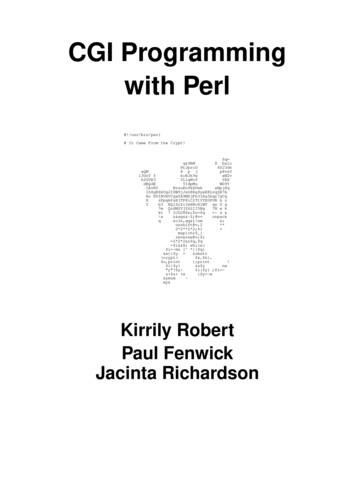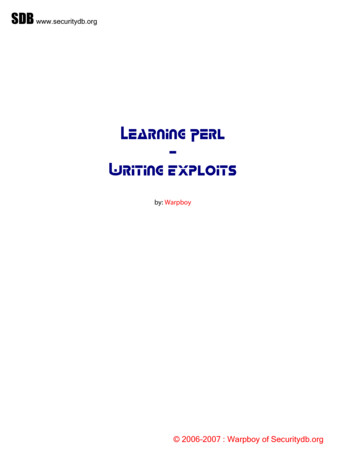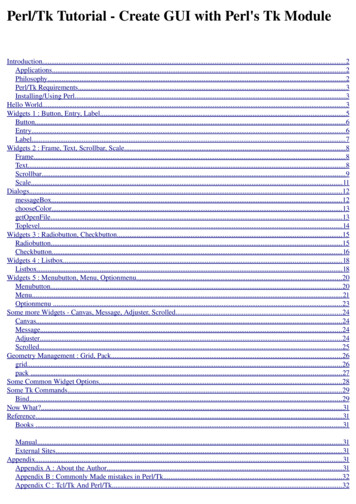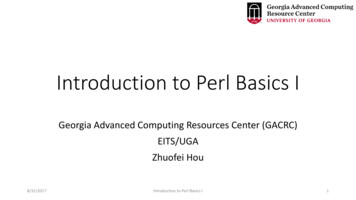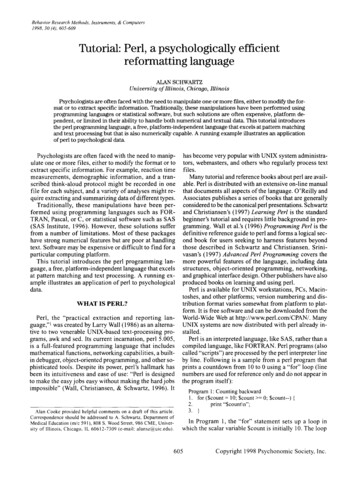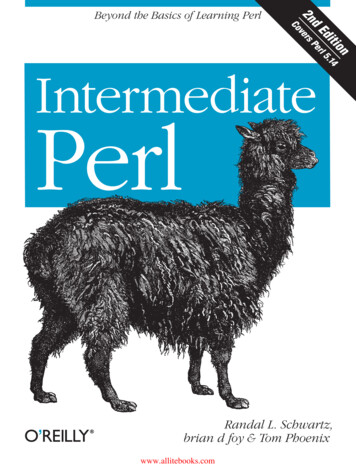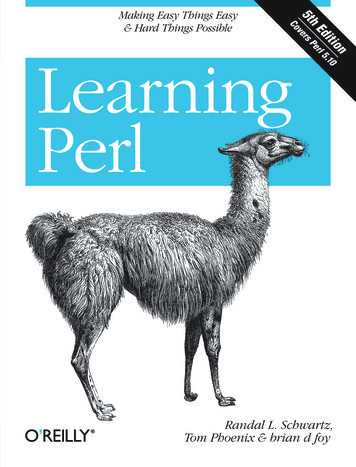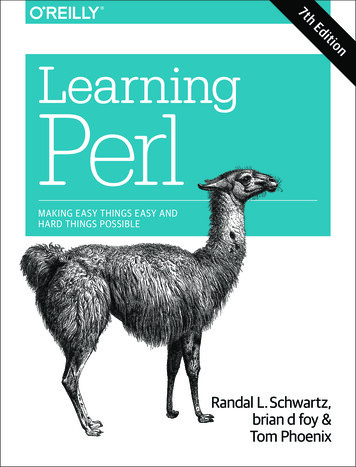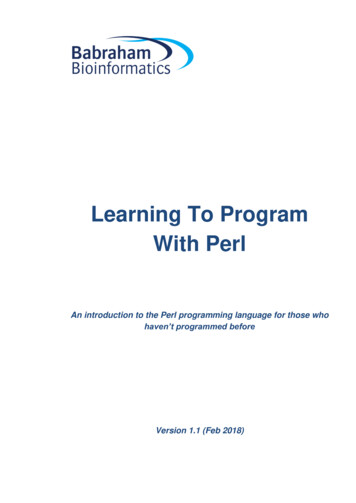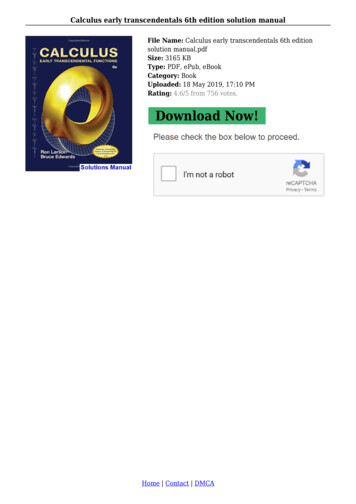
Transcription
Download from Wow! eBook www.wowebook.com Learning Perl
SIXTH EDITIONLearning PerlRandal L. Schwartz, brian d foy, and Tom PhoenixBeijing Cambridge Farnham Köln Sebastopol Tokyo
Learning Perl, Sixth Editionby Randal L. Schwartz, brian d foy, and Tom PhoenixCopyright 2011 Randal L. Schwartz, brian d foy, and Tom Phoenix. All rights reserved.Printed in the United States of America.Published by O’Reilly Media, Inc., 1005 Gravenstein Highway North, Sebastopol, CA 95472.O’Reilly books may be purchased for educational, business, or sales promotional use. Online editionsare also available for most titles (http://my.safaribooksonline.com). For more information, contact ourcorporate/institutional sales department: (800) 998-9938 or corporate@oreilly.com.Editor: Simon St.LaurentProduction Editor: Kristen BorgCopyeditor: Audrey DoyleProofreader: Kiel Van HornIndexer: John BickelhauptCover Designer: Karen MontgomeryInterior Designer: David FutatoIllustrator: Robert RomanoPrinting History:November 1993:July 1997:July 2001:July 2005:July 2008:June 2011:First Edition.Second Edition.Third Edition.Fourth Edition.Fifth Edition.Sixth Edition.Nutshell Handbook, the Nutshell Handbook logo, and the O’Reilly logo are registered trademarks ofO’Reilly Media, Inc. Learning Perl, the image of a llama, and related trade dress are trademarks ofO’Reilly Media, Inc.Many of the designations used by manufacturers and sellers to distinguish their products are claimed astrademarks. Where those designations appear in this book, and O’Reilly Media, Inc., was aware of atrademark claim, the designations have been printed in caps or initial caps.While every precaution has been taken in the preparation of this book, the publisher and authors assumeno responsibility for errors or omissions, or for damages resulting from the use of the information contained herein.ISBN: 978-1-449-30358-7[LSI]1308077187
Table of ContentsPreface . . . . . . . . . . . . . . . . . . . . . . . . . . . . . . . . . . . . . . . . . . . . . . . . . . . . . . . . . . . . . . . . . . . . xiii1. Introduction . . . . . . . . . . . . . . . . . . . . . . . . . . . . . . . . . . . . . . . . . . . . . . . . . . . . . . . . . . . 1Questions and AnswersIs This the Right Book for You?Why Are There So Many Footnotes?What About the Exercises and Their Answers?What Do Those Numbers Mean at the Start of the Exercise?What If I’m a Perl Course Instructor?What Does “Perl” Stand For?Why Did Larry Create Perl?Why Didn’t Larry Just Use Some Other Language?Is Perl Easy or Hard?How Did Perl Get to Be So Popular?What’s Happening with Perl Now?What’s Perl Really Good For?What Is Perl Not Good For?How Can I Get Perl?What Is CPAN?How Can I Get Support for Perl?Are There Any Other Kinds of Support?What If I Find a Bug in Perl?How Do I Make a Perl Program?A Simple ProgramWhat’s Inside That Program?How Do I Compile My Perl Program?A Whirlwind Tour of PerlExercises112344455677889101010121213151617182. Scalar Data . . . . . . . . . . . . . . . . . . . . . . . . . . . . . . . . . . . . . . . . . . . . . . . . . . . . . . . . . . . 21Numbers21v
All Numbers Have the Same Format InternallyFloating-Point LiteralsInteger LiteralsNondecimal Integer LiteralsNumeric OperatorsStringsSingle-Quoted String LiteralsDouble-Quoted String LiteralsString OperatorsAutomatic Conversion Between Numbers and StringsPerl’s Built-in WarningsScalar VariablesChoosing Good Variable NamesScalar AssignmentBinary Assignment OperatorsOutput with printInterpolation of Scalar Variables into StringsCreating Characters by Code PointOperator Precedence and AssociativityComparison OperatorsThe if Control StructureBoolean ValuesGetting User InputThe chomp OperatorThe while Control StructureThe undef ValueThe defined 234343637383939404142423. Lists and Arrays . . . . . . . . . . . . . . . . . . . . . . . . . . . . . . . . . . . . . . . . . . . . . . . . . . . . . . . . 43Accessing Elements of an ArraySpecial Array IndicesList LiteralsThe qw ShortcutList AssignmentThe pop and push OperatorsThe shift and unshift OperatorsThe splice OperatorInterpolating Arrays into StringsThe foreach Control StructurePerl’s Favorite Default: The reverse OperatorThe sort Operatorvi Table of Contents44454646484950505153545454
The each OperatorScalar and List ContextUsing List-Producing Expressions in Scalar ContextUsing Scalar-Producing Expressions in List ContextForcing Scalar Context STDIN in List ContextExercises555557585959604. Subroutines . . . . . . . . . . . . . . . . . . . . . . . . . . . . . . . . . . . . . . . . . . . . . . . . . . . . . . . . . . . 63Defining a SubroutineInvoking a SubroutineReturn ValuesArgumentsPrivate Variables in SubroutinesVariable-Length Parameter ListsA Better &max RoutineEmpty Parameter ListsNotes on Lexical (my) VariablesThe use strict PragmaThe return OperatorOmitting the AmpersandNon-Scalar Return ValuesPersistent, Private VariablesExercises6364646668696970717274747676785. Input and Output . . . . . . . . . . . . . . . . . . . . . . . . . . . . . . . . . . . . . . . . . . . . . . . . . . . . . . 81Input from Standard InputInput from the Diamond OperatorThe Invocation ArgumentsOutput to Standard OutputFormatted Output with printfArrays and printfFilehandlesOpening a FilehandleBinmoding FilehandlesBad FilehandlesClosing a FilehandleFatal Errors with dieWarning Messages with warnAutomatically die-ingUsing FilehandlesChanging the Default Output FilehandleReopening a Standard le of Contents vii
Output with sayFilehandles in a ScalarExercises1021031046. Hashes . . . . . . . . . . . . . . . . . . . . . . . . . . . . . . . . . . . . . . . . . . . . . . . . . . . . . . . . . . . . . . 107What Is a Hash?Why Use a Hash?Hash Element AccessThe Hash As a WholeHash AssignmentThe Big ArrowHash FunctionsThe keys and values FunctionsThe each FunctionTypical Use of a HashThe exists FunctionThe delete FunctionHash Element InterpolationThe %ENV 191191207. In the World of Regular Expressions . . . . . . . . . . . . . . . . . . . . . . . . . . . . . . . . . . . . . . 121What Are Regular Expressions?Using Simple PatternsUnicode PropertiesAbout MetacharactersSimple QuantifiersGrouping in PatternsAlternativesCharacter ClassesCharacter Class ShortcutsNegating the 18. Matching with Regular Expressions . . . . . . . . . . . . . . . . . . . . . . . . . . . . . . . . . . . . . . 133Matches with m//Match ModifiersCase-Insensitive Matching with /iMatching Any Character with /sAdding Whitespace with /xCombining Option ModifiersChoosing a Character InterpretationOther Optionsviii Table of Contents133134134134135135136138
AnchorsWord AnchorsThe Binding Operator Interpolating into PatternsThe Match VariablesThe Persistence of CapturesNoncapturing ParenthesesNamed CapturesThe Automatic Match VariablesGeneral QuantifiersPrecedenceExamples of PrecedenceAnd There’s MoreA Pattern Test 511521521539. Processing Text with Regular Expressions . . . . . . . . . . . . . . . . . . . . . . . . . . . . . . . . . 155Substitutions with s///Global Replacements with /gDifferent DelimitersSubstitution ModifiersThe Binding OperatorNondestructive SubstitutionsCase ShiftingThe split OperatorThe join Functionm// in List ContextMore Powerful Regular ExpressionsNongreedy QuantifiersMatching Multiple-Line TextUpdating Many FilesIn-Place Editing from the Command 6416416616810. More Control Structures . . . . . . . . . . . . . . . . . . . . . . . . . . . . . . . . . . . . . . . . . . . . . . . . 169The unless Control StructureThe else Clause with unlessThe until Control StructureExpression ModifiersThe Naked Block Control StructureThe elsif ClauseAutoincrement and AutodecrementThe Value of Autoincrement169170170171172173174175Table of Contents ix
The for Control StructureThe Secret Connection Between foreach and forLoop ControlsThe last OperatorThe next OperatorThe redo OperatorLabeled BlocksThe Conditional Operator ?:Logical OperatorsThe Value of a Short Circuit OperatorThe defined-or OperatorControl Structures Using Partial-Evaluation 518618811. Perl Modules . . . . . . . . . . . . . . . . . . . . . . . . . . . . . . . . . . . . . . . . . . . . . . . . . . . . . . . . . 189Finding ModulesInstalling ModulesUsing Your Own DirectoriesUsing Simple ModulesThe File::Basename ModuleUsing Only Some Functions from a ModuleThe File::Spec ModulePath::ClassCGI.pmDatabases and DBIDates and 12. File Tests . . . . . . . . . . . . . . . . . . . . . . . . . . . . . . . . . . . . . . . . . . . . . . . . . . . . . . . . . . . . 203File Test OperatorsTesting Several Attributes of the Same FileStacked File Test OperatorsThe stat and lstat FunctionsThe localtime FunctionBitwise OperatorsUsing BitstringsExercises20320720821021121221321413. Directory Operations . . . . . . . . . . . . . . . . . . . . . . . . . . . . . . . . . . . . . . . . . . . . . . . . . . 215Moving Around the Directory TreeGlobbingAn Alternate Syntax for GlobbingDirectory Handlesx Table of Contents215216217218
Recursive Directory ListingManipulating Files and DirectoriesRemoving FilesRenaming FilesLinks and FilesMaking and Removing DirectoriesModifying PermissionsChanging OwnershipChanging 4. Strings and Sorting . . . . . . . . . . . . . . . . . . . . . . . . . . . . . . . . . . . . . . . . . . . . . . . . . . . . 235Finding a Substring with indexManipulating a Substring with substrFormatting Data with sprintfUsing sprintf with “Money Numbers”Interpreting Non-Decimal NumeralsAdvanced SortingSorting a Hash by ValueSorting by Multiple KeysExercises23523623823824024024424524615. Smart Matching and given-when . . . . . . . . . . . . . . . . . . . . . . . . . . . . . . . . . . . . . . . . 247The Smart Match OperatorSmart Match PrecedenceThe given StatementDumb MatchingUsing when with Many ItemsExercises24725025125425625716. Process Management . . . . . . . . . . . . . . . . . . . . . . . . . . . . . . . . . . . . . . . . . . . . . . . . . . 259The system FunctionAvoiding the ShellThe Environment VariablesThe exec FunctionUsing Backquotes to Capture OutputUsing Backquotes in a List ContextExternal Processes with IPC::System::SimpleProcesses as FilehandlesGetting Down and Dirty with ForkSending and Receiving able of Contents xi
Download from Wow! eBook www.wowebook.com 17. Some Advanced Perl Techniques . . . . . . . . . . . . . . . . . . . . . . . . . . . . . . . . . . . . . . . . 277SlicesArray SliceHash SliceTrapping ErrorsUsing evalMore Advanced Error HandlingautodiePicking Items from a List with grepTransforming Items from a List with mapFancier List 3A. Exercise Answers . . . . . . . . . . . . . . . . . . . . . . . . . . . . . . . . . . . . . . . . . . . . . . . . . . . . . 295B. Beyond the Llama . . . . . . . . . . . . . . . . . . . . . . . . . . . . . . . . . . . . . . . . . . . . . . . . . . . . 331C. A Unicode Primer . . . . . . . . . . . . . . . . . . . . . . . . . . . . . . . . . . . . . . . . . . . . . . . . . . . . . 343Index . . . . . . . . . . . . . . . . . . . . . . . . . . . . . . . . . . . . . . . . . . . . . . . . . . . . . . . . . . . . . . . . . . . . . 353xii Table of Contents
PrefaceWelcome to the sixth edition of Learning Perl, updated for Perl 5.14 and its latestfeatures. This book is still good even if you are still using Perl 5.8 (although, it’s beena long time since it was released; have you thought about upgrading?).If you’re looking for the best way to spend your first 30 to 45 hours with the Perlprogramming language, you’ve found it. In the pages that follow, you’ll find a carefullypaced introduction to the language that is the workhorse of the Internet, as well as thelanguage of choice for system administrators, web hackers, and casual programmersaround the world.We can’t give you all of Perl in just a few hours. The books that promise that areprobably fibbing a bit. Instead, we’ve carefully selected a useful subset of Perl for youto learn, good for programs from one to 128 lines long, which end up being about 90%of the programs in use out there. And when you’re ready to go on, you can get Intermediate Perl, which picks up where this book leaves off. We’ve also included a numberof pointers for further education.Each chapter is small enough so you can read it in an hour or two. Each chapter endswith a series of exercises to help you practice what you’ve just learned, with the answersin Appendix A for your reference. Thus, this book is ideally suited for a classroom“Introduction to Perl” course. We know this directly because the material for this bookwas lifted almost word-for-word from our flagship “Learning Perl” course, deliveredto thousands of students around the world. However, we’ve designed the book for selfstudy as well.Perl lives as the “toolbox for Unix,” but you don’t have to be a Unix guru, or even aUnix user, to read this book. Unless otherwise noted, everything we’re saying appliesequally well to Windows ActivePerl from ActiveState and pretty much every othermodern implementation of Perl.Although you don’t need to know a single thing about Perl to begin reading this book,we recommend that you already have familiarity with basic programming conceptssuch as variables, loops, subroutines, and arrays, and the all-important “editing asource code file with your favorite text editor.” We don’t spend any time trying toexplain those concepts. Although we’re pleased that we’ve had many reports of peoplexiii
successfully picking up Learning Perl and grasping Perl as their first programming language, of course we can’t promise the same results for everyone.Typographical ConventionsThe following font conventions are used in this book:Constant widthis used for method names, function names, variables, and attributes. It is also usedfor code examples.Constant width boldis used to indicate user input.Constant width italicis used to indicate a replaceable item in code (e.g., filename, where you are supposed to substitute an actual filename).Italicis used for filenames, URLs, hostnames, commands in text, important words onfirst mention, and emphasis.Footnotesare used to attach parenthetical notes that you should not read on your first (orperhaps second or third) reading of this book. Sometimes lies are spoken to simplifythe presentation, and the footnotes restore the lie to truth. Often the material inthe footnote will be advanced material not even mentioned anywhere else in thebook.[2]at the start of an exercise’s text represents our (very rough) estimate of how manyminutes you can expect to spend on that particular exercise.Code ExamplesThis book is here to help you get your job done. You are invited to copy the code inthe book and adapt it for your own needs. Rather than copying by hand, however, weencourage you to download the code from http://www.learning-perl.com.In general, you may use the code in this book in your programs and documentation.You do not need to contact us for permission unless you’re reproducing a significantportion of the code. For example, writing a program that uses several chunks of codefrom this book does not require permission. Selling or distributing a CD-ROM of examples from O’Reilly books does require permission. Answering a question by citingthis book and quoting example code does not require permission. Incorporating a significant amount of example code from this book into your product’s documentationdoes require permission.xiv Preface
We appreciate, but do not require, attribution. An attribution usually includes the title,authors, publisher, and ISBN. For example: “Learning Perl, 6th edition, by Randal L.Schwartz, brian d foy, and Tom Phoenix (O’Reilly). Copyright 2011 Randal L.Schwartz, brian d foy, and Tom Phoenix, 978-1-449-30358-7.” If you feel your use ofcode examples falls outside fair use or the permission given above, feel free to contactus at permissions@oreilly.comSafari Books OnlineSafari Books Online is an on-demand digital library that lets you easilysearch over 7,500 technology and creative reference books and videos tofind the answers you need quickly.With a subscription, you can read any page and watch any video from our library online.Read books on your cell phone and mobile devices. Access new titles before they areavailable for print, and get exclusive access to manuscripts in development and postfeedback for the authors. Copy and paste code samples, organize your favorites, download chapters, bookmark key sections, create notes, print out pages, and benefit fromtons of other time-saving features.O’Reilly Media has uploaded this book to the Safari Books Online service. To have fulldigital access to this book and others on similar topics from O’Reilly and other publishers, sign up for free at http://my.safaribooksonline.com.How to Contact UsWe have tested and verified all the information in this book to the best of our abilities,but you may find that features have changed or that we have let errors slip through theproduction of the book. Please let us know of any errors that you find, as well as suggestions for future editions, by writing to:O’Reilly Media, Inc.1005 Gravenstein Highway NorthSebastopol, CA 95472800-998-9938 (in the United States or Canada)707-829-0515 (international or local)707-829-0104 (fax)We have a web page for the book, where we’ll list examples, errata, and any additionalinformation. It also offers a downloadable set of text files (and a couple of Perl programs) that are useful, but not required, when doing some of the exercises. You canaccess this page at:http://www.learning-perl.comPreface xv
or go to the O’Reilly page at:http://oreilly.com/catalog/0636920018452/To comment or ask technical questions about this book, send email to:bookquestions@oreilly.comFor more information about our books, courses, conferences, and news, see our websiteat http://www.oreilly.com.Find us on Facebook: http://facebook.com/oreillyFollow us on Twitter: http://twitter.com/oreillymediaWatch us on YouTube: http://www.youtube.com/oreillymediaHistory of This BookFor the curious, here’s how Randal tells the story of how this book came about:After I had finished the first Programming perl book with Larry Wall (in 1991), I wasapproached by Taos Mountain Software in Silicon Valley to produce a training course.This included having me deliver the first dozen or so courses and train their staff tocontinue offering the course. I wrote the course for them* and delivered it for them aspromised.On the third or fourth delivery of that course (in late 1991), someone came up to meand said, “You know, I really like Programming perl, but the way the material is presented in this course is so much easier to follow—you oughta write a book like thiscourse.” It sounded like an opportunity to me, so I started thinking about it.I wrote to Tim O’Reilly with a proposal based on an outline that was similar to thecourse I was presenting for Taos—although I had rearranged and modified a few of thechapters based on observations in the classroom. I think that was my fastest proposalacceptance in history—I got a message from Tim within fifteen minutes, saying “We’vebeen waiting for you to pitch a second book—Programming perl is selling like gangbusters.” That started the effort over the next 18 months to finish the first edition ofLearning Perl.During that time, I was starting to see an opportunity to teach Perl classes outsideSilicon Valley,† so I created a class based on the text I was writing for Learning Perl. Igave a dozen classes for various clients (including my primary contractor, Intel Oregon),and used the feedback to fine-tune the book draft even further.* In the contract, I retained the rights to the exercises, hoping someday to reuse them in some other way, likein the magazine columns I was writing at the time. The exercises are the only things that leapt from the Taoscourse to the book.† My Taos contract had a no-compete clause, so I had to stay out of Silicon Valley with any similar courses,which I respected for many years.xvi Preface
The first edition hit the streets on the first day of November 1993,‡ and became asmashing success, frequently even outpacing Programming perl book sales.The back-cover jacket of the first book said “written by a leading Perl trainer.” Well,that became a self-fulfilling prophecy. Within a few months, I was starting to get emailfrom all over the United States asking me to teach at their site. In the following sevenyears, my company became the leading worldwide on-site Perl training company, andI had personally racked up (literally) a million frequent-flier miles. It didn’t hurt thatthe Web started taking off about then, and the webmasters and webmistresses pickedPerl as the language of choice for content management, interaction through CGI, andmaintenance.For two years, I worked closely with Tom Phoenix in his role as lead trainer and contentmanager for Stonehenge, giving him charter to experiment with the “Llama” course bymoving things around and breaking things up. When we had come up with what wethought was the best major revision of the course, I contacted O’Reilly and said, “It’stime for a new book!” And that became the third edition.Two years after writing the third edition of the Llama, Tom and I decided it was timeto push our follow-on “advanced” course out into the world as a book, for peoplewriting programs that are “100 to 10,000 lines of code.” And together we created thefirst Alpaca book, released in 2003.But fellow instructor brian d foy was just getting back from the conflict in the Gulf, andhad noticed that we could use some rewriting in both books, because our coursewarestill needed to track the changing needs of the typical student. So, he pitched the ideato O’Reilly to take on rewriting both the Llama and the Alpaca one final time beforePerl 6 (we hope). This edition of the Llama reflects those changes. brian has really beenthe lead writer here, working with my occasional guidance, and has done a brilliant jobof the usual “herding cats” that a multiple-writer team generally feels like.On December 18, 2007, the Perl 5 Porters released Perl 5.10, a significant new versionof Perl with several new features. The previous version, 5.8, had focused on the underpinnings of Perl and its Unicode support. The latest version, starting from the stable5.8 foundation, was able to add completely new features, some of which it borrowedfrom the development of Perl 6 (not yet released). Some of these features, such as namedcaptures in regular expressions, are much better than the old ways of doing things, thusperfect for Perl beginners. We hadn’t thought about a fifth edition of this book, butPerl 5.10 was so much better that we couldn’t resist.Since then, Perl has been under constant improvement and is keeping a regular releasecycle. We didn’t have a chance to update this book for Perl 5.12 because developmentproceeded too quickly. We’re pleased to offer this update for Perl 5.14, and are amazedthat there’s now a sixth edition.‡ I remember that date very well, because it was also the day I was arrested at my home for computer-relatedactivities around my Intel contract, a series of felony charges for which I was later convicted.Preface xvii
Changes from the Previous EditionThe text is updated for the latest version, Perl 5.14, and some of the code only workswith that version. We note in the text when we are talking about a Perl 5.14 feature,and we mark those code sections with a special use statement that ensures you’re usingthe right version:use 5.014; # this script requires Perl 5.14 or greaterIf you don’t see that use 5.014 in a code example (or a similar statement with a differentversion), it should work all the way back to Perl 5.8. To see which version of Perl youhave, try the -v command-line switch: perl -vHere’s some of the new features from Perl 5.14 that we cover, and where appropriate,we still show you the old ways of doing the same thing: We include Unicode examples and features where appropriate. If you haven’t started playing with Unicode, we include a primer in Appendix C. You have to bitethe bullet sometime, so it might as well be now. You’ll see Unicode throughoutthe book, most notably in the chapters on Scalars (Chapter 2), Input/Output(Chapter 5), and Sorting (Chapter 14). There is more information in the regular expression chapters, covering the newfeatures from Perl 5.14 to deal with Unicode case-folding. The regular expressionoperators have new /a, /u, and /l switches. We now cover matching by Unicodeproperties with the \p{} and \P{} regular expression features. Perl 5.14 adds a nondestructive substitution operator (Chapter 9), which turns outto be really handy. Smart matching and given-when has mutated a bit since their introduction in Perl5.10, so we update Chapter 15 to cover the new rules. We updated and expanded Perl Modules (Chapter 11) to include the latest news,including the zero-conf cpanm tool. We add some more module examples as well. Some of the items previously in Appendix B, the advanced-but-not-demonstratedfeatures, move into the main text. Notably, that includes the fat arrow movinginto Hashes (Chapter 6) and splice moving into Lists and Arrays (Chapter 3).AcknowledgmentsFrom RandalI want to thank the Stonehenge trainers past and present (Joseph Hall, Tom Phoenix,Chip Salzenberg, brian d foy, and Tad McClellan) for their willingness to go out andteach in front of classrooms week after week and to come back with their notes aboutxviii Preface
what’s working (and what’s not), so we could fine-tune the material for this book. Iespecially want to single out my co-author and business associate, Tom Phoenix, forhaving spent many, many hours working to improve Stonehenge’s Llama course andto provide the wonderful core text for most of this book. And brian d foy for being thelead writer beginning with the fourth edition, and taking that eternal to-do item out ofmy inbox so that it would finally happen.I also want to thank everyone at O’Reilly, especially our very patient editor and overseerfor previous editions, Allison Randal (no relation, but she has a nicely spelled lastname), current editor Simon St.Laurent, and Tim O’Reilly himself for taking a chanceon me in the first place with the Camel and Llama books.I am also absolutely indebted to the thousands of people who have purchased the pasteditions of the Llama so that I could use the money to stay “off the streets and out ofjail,” and to those students in my classrooms who have trained me to be a better trainer,and to the stunning array of Fortune 1000 clients who have purchased our classes inthe past and will continue to do so into the future.As always, a special thanks to Lyle and Jack, for teaching me nearly everything I knowabout writing. I won’t ever forget you guys.From TomI’ve got to echo Randal’s thanks to everyone at O’Reilly. For the third edition of thisbook, Linda Mui was our editor, and I still thank her, for her patience in pointing outwhich jokes and footnotes were most excessive, while pointing out that she is in noway to blame for the ones that remain. Both she and Randal have guided me throughthe process of writing, and I am grateful. In a previous edition, Allison Randal tookcharge; now Simon St.Laurent has become the editor. My thanks go to each of themin recognition of their unique contributions.And another echo with regard to Randal and the other Stonehenge trainers, who hardlyever complained when I unexpectedly updated the course materials to try out a newteaching technique. You folks have contributed many different viewpoints on teachingmethods that I would never have seen.For many years, I worked at the Oregon Museum of Science and Industry (OMSI), andI’d like to thank the folks there for letting me hone my teaching skills as I learned tobuild a joke or two into every activity, explosion, or dissection.To the many folks on Usenet who have given me your appreciation and encouragementfor my contributions there, thanks. As always, I hope this helps.Also to my many students, who have shown me with their questions (and befuddledlooks) when I needed to try a new way of expressing a concept. I hope that the presentedition helps to relieve any remaining puzzlement.Preface xix
Of course, deep thanks are due especially to my co-author, Randal, for giving me thefreedom to try various ways of presenting the material both in the classroom and herein the book, as well as for the push to make this material into a book in the first place.And without fail, I must say that I am indeed inspired by your ongoing work to ensurethat no one else becomes ensnared by the legal troubles that have stolen so much ofyour time and energy; you’re a fine example.To my wife, Jenna, thanks for being a cat person, and everything thereafter.From brianI have to thank Randal first, since I learned Perl from the first edition of this book, andthen had to learn it again when he asked me to start teaching for Stonehenge in 1998.Teaching is often the best way to learn. Since then, Randal has mentored me not onlyin Perl but several other things he thought I needed to learn—like the time he decidedthat we could use Smalltalk instead of Perl for a demonstration at a web conference.I’m always amazed at the breadth of his knowledge. He’s the one who told me to startwriting about Perl. Now I’m helping out on the book where
Welcome to the sixth edition of Learning Perl, updated for Perl 5.14 and its latest features. This book is still good even if you are still using Perl 5.8 (although, it's been . was lifted almost word-for-word from our flagship "Learning Perl" course, delivered to thousands of students around the world. However, we've designed the .
